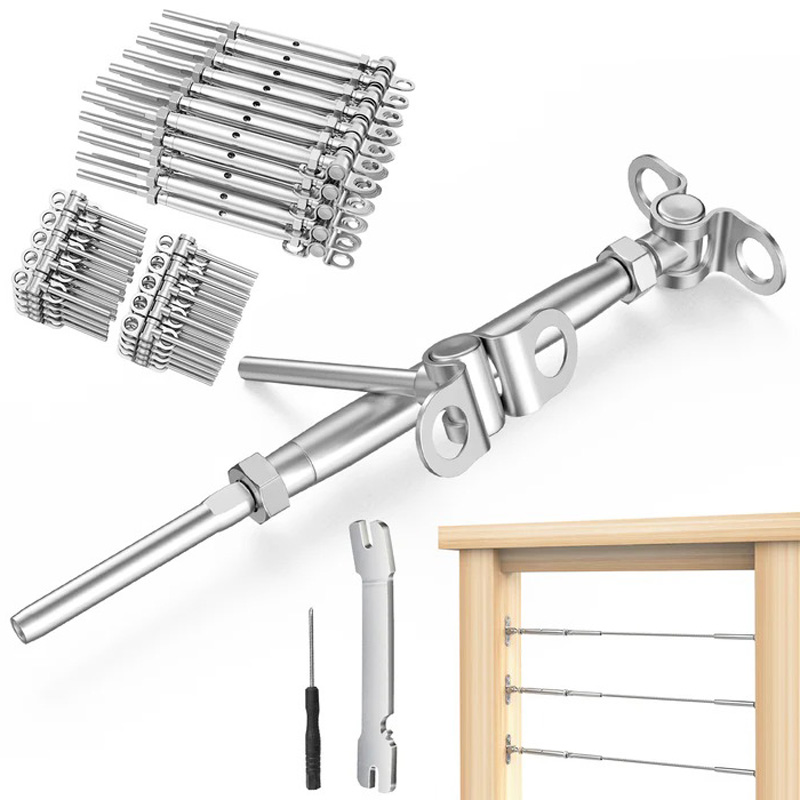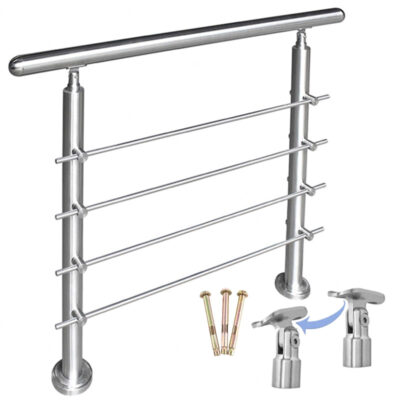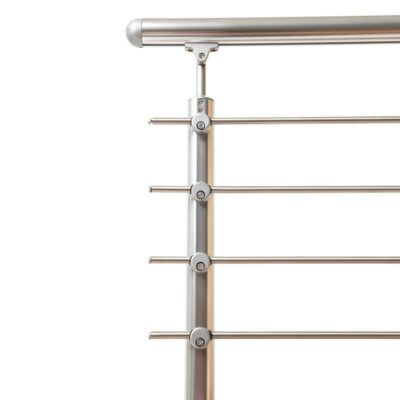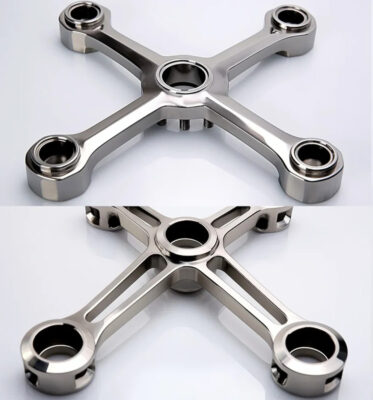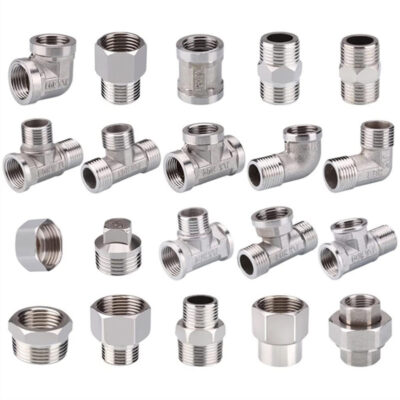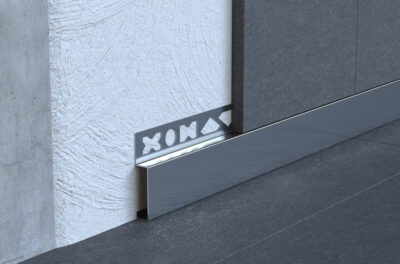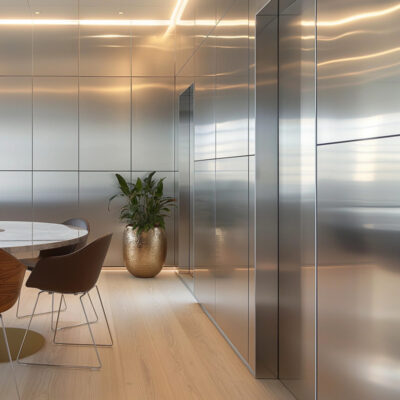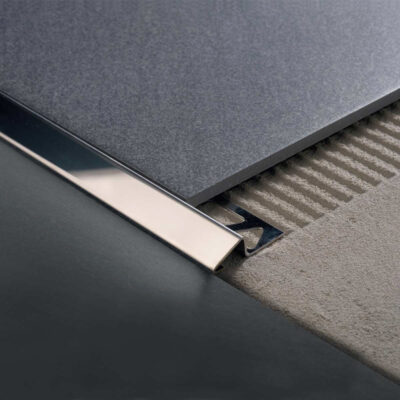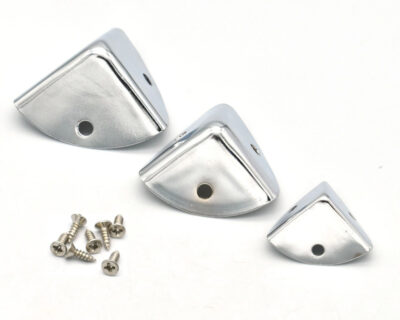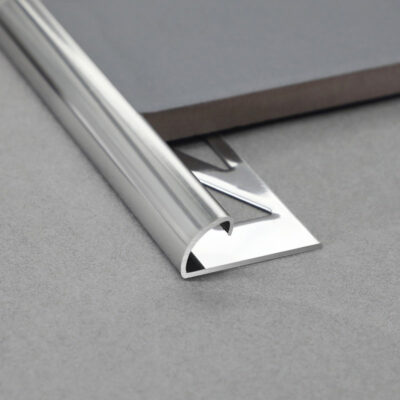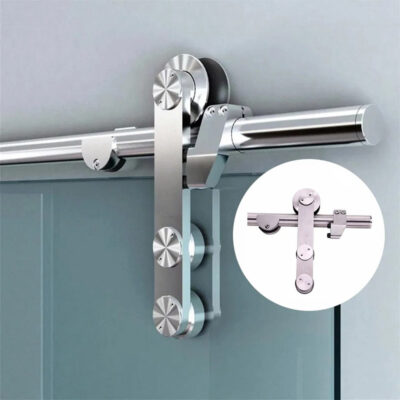The Evolution of Cable Railing Systems
I first encountered cable railing systems about fifteen years ago when visiting a newly constructed oceanfront property in California. What struck me wasn’t just the unobstructed views they provided, but how the thin horizontal lines seemed to disappear against the backdrop of the horizon. Since that moment, I’ve watched these systems transform from novelty architectural elements into mainstream features in both residential and commercial settings.
Cable railing systems have undergone significant evolution over the past few decades. Originally pioneered in commercial marine applications, these systems have migrated to residential and commercial construction, bringing their durability and minimal visual footprint along with them. The core appeal remains unchanged: stainless steel cable railing components offer an elegant solution that maximizes views while maintaining structural integrity and safety compliance.
The market for stainless steel cable railing components has expanded dramatically as architects and homeowners increasingly value open sight lines and contemporary aesthetics. This growth has driven innovation in component design, material science, and installation techniques. What once required specialized fabrication now comes in modular systems that skilled contractors and even ambitious DIYers can install.
A building contractor I regularly collaborate with, James Merritt, pointed out something interesting: “The current generation of stainless steel cable railing components represents a significant advancement over earlier systems. We’re seeing improved tensioning mechanisms that maintain their settings longer, more versatile mounting options, and components engineered specifically for DIY installation.”
Core Components of Stainless Steel Cable Railing Systems
Understanding the individual elements that make up a complete cable railing system is essential before embarking on any installation project. Each component plays a specific role in the system’s structural integrity, appearance, and longevity.
Posts and Mounting Hardware
The posts serve as the vertical structural elements anchoring the entire system. Typically spaced between 3 to 4 feet apart (0.9 to 1.2 meters), these posts must withstand significant lateral forces when cables are properly tensioned.
Several mounting options exist for posts:
- Surface mounting: Using base plates attached to horizontal surfaces
- Fascia mounting: Attaching to vertical surfaces like deck fascia boards
- Core mounting: Installing directly into concrete during pouring
- Embedded mounting: Setting posts into pre-drilled holes in existing concrete
The quality of mounting hardware significantly impacts system stability. High-grade stainless steel lag screws, through bolts, or concrete anchors are essential for long-term performance. Many manufactured systems from E-Sang include specialized hardware designed specifically for their components, ensuring optimal compatibility and load distribution.
Cable and Cable Assemblies
The horizontal elements—stainless steel cables—are available in various diameters, with 1/8″ and 3/16″ (3mm and 4.8mm) being most common for residential applications. These cables typically feature construction known as 7×7 or 7×19, indicating the number of strands and wires per strand.
| Cable Type | Construction | Typical Applications | Breaking Strength | Flexibility |
|---|---|---|---|---|
| 1/8″ (3mm) | 7×7 | Residential, light commercial | 1,700 lbs (770 kg) | Good |
| 3/16″ (4.8mm) | 7×7 | Residential, commercial | 3,700 lbs (1,678 kg) | Moderate |
| 1/8″ (3mm) | 7×19 | Residential, decorative | 1,800 lbs (816 kg) | Excellent |
| 3/16″ (4.8mm) | 7×19 | Commercial, high-traffic | 3,900 lbs (1,769 kg) | Good |
Cable assemblies come in two primary configurations:
- Hand-crimp systems: Requiring specialized tools but offering clean, factory-like finishes
- Mechanical fitting systems: Using threaded components that can be installed with standard wrenches
The choice between these systems often depends on the installer’s experience level and available tools. During a recent project in a historic building renovation, I opted for mechanical fittings despite their slightly higher visible profile, primarily because they allowed for adjustments as the building settled.
Tensioners and End Fittings
Proper tensioning is crucial for both safety and aesthetics. Several tensioning mechanisms are available:
- Threaded terminals: Allow for tension adjustment with wrenches
- Turnbuckles: Provide significant adjustment range through rotation
- Internal tensioners: Hide the tensioning mechanism inside posts for cleaner appearance
- Swageless fittings: Combine end termination and tensioning in a single component
End fittings connect cables to posts and include:
- Lag studs: Screw directly into wooden posts
- Through-hole fittings: Pass through metal posts with nuts securing them
- Stop-end fittings: Create a clean termination that prevents cable from pulling through
One experienced installer I consulted, Maria Cortez, emphasized an important point: “The quality of tensioners directly correlates to long-term performance. Cheaper components often fail to maintain tension over time, leading to sagging cables and potential code violations.”
Material Considerations for Long-Term Performance
The material selection for stainless steel cable railing components significantly impacts system performance, particularly in challenging environments. Not all stainless steel is created equal, and understanding the distinctions is crucial.
Stainless Steel Grades and Their Properties
The most commonly used grades for cable railing components include:
| Grade | Composition | Corrosion Resistance | Typical Applications | Relative Cost |
|---|---|---|---|---|
| 304 | 18% chromium, 8% nickel | Good | Standard residential, protected areas | Baseline |
| 316 | 16% chromium, 10% nickel, 2% molybdenum | Excellent | Coastal areas, pools, high humidity | 15-30% higher |
| 2205 | 22% chromium, 5% nickel, 3% molybdenum | Superior | Marine environments, chemical exposure | 40-60% higher |
| 17-4PH | 17% chromium, 4% nickel + copper, phosphorus | Very good | High-strength applications | 25-40% higher |
While examining corroded components during a renovation project last year, I discovered the previous installer had used 304 grade components in a pool area—a classic mistake. The chlorinated environment had accelerated corrosion, leading to premature failure. For applications within 15 miles of saltwater or around pools, 316 grade should be the minimum standard.
Metallurgist Dr. Karen Westfall explains: “The addition of molybdenum in 316 stainless steel creates significantly improved resistance to chlorides and salt environments. This small material upgrade can extend component life by decades in challenging environments.”
Surface Finishes and Their Impact
Stainless steel components are available in several surface finishes, each affecting both aesthetics and performance:
- Mill finish: Unpolished standard production finish
- Brushed/satin finish: Fine linear texture, most common for railings
- Mirror polished: Highly reflective, shows fingerprints easily
- Bead blasted: Uniform matte texture with excellent grip properties
The surface finish choice extends beyond aesthetics—it affects maintenance requirements and longevity. Mirror finishes, while striking, show fingerprints and smudges prominently. Brushed finishes tend to conceal minor scratches better. For applications where grip matters, such as handrails, bead-blasted finishes provide functional benefits.
During an interview with an architectural metals specialist, I was surprised to learn that the microscopic surface characteristics of different finishes actually affect corrosion resistance. Smoother finishes provide fewer crevices where corrosive elements can accumulate, potentially extending component life.
Installation Techniques and Best Practices
Even the highest quality stainless steel cable railing components can fail prematurely if installed incorrectly. My conversations with professional installers consistently highlight several critical areas where proper technique significantly impacts system performance.
Post Spacing and Structural Considerations
Post spacing directly affects both the aesthetic and structural integrity of cable railing systems. While building codes typically require posts to support certain loads, the practical consideration is cable deflection—how much the cable “gives” when pressure is applied.
Generally, posts should be spaced:
- For residential applications: 3 to 4 feet (0.9 to 1.2 meters) apart
- For commercial applications: 3 feet (0.9 meters) or less
- When using heavier gauge cables: Up to 5 feet (1.5 meters) may be acceptable
The structural integrity of posts themselves is equally important. For wood posts, 4×4 inches is the minimum recommended dimension, though 6×6 provides better stability for heights exceeding 36 inches. Metal posts require proper wall thickness based on height and expected loads.
During a challenging installation on an oceanfront deck, I encountered significant issues with a previous installer’s work. They had attempted to space posts at 6-foot intervals to save on materials, resulting in excessive cable deflection that failed code inspection.
Cable Tensioning Techniques
Proper tensioning requires both technique and appropriate tools. Cables that are too loose fail safety standards, while over-tensioned cables can damage components or warp wooden posts.
A sequential tensioning approach works best:
- Install all cables loosely through the system
- Begin initial tensioning starting from the middle cable, working outward
- Follow with a second round of tensioning using the same pattern
- Allow the system to settle for 24-48 hours
- Perform final tensioning adjustments
Tools required typically include:
- Cable cutters designed for stainless steel
- Wrenches sized appropriately for tensioning hardware
- Tension gauges (recommended for precision)
- Crimping tools (for swaged fittings)
Safety expert Michael Torres notes: “One of the most common code failures we see is improper cable spacing and tensioning. Building inspectors will often check cable deflection with a simple pressure test—if cables deflect more than 4 inches with moderate pressure, they’ll fail inspection.”
Intermediate Pickets and Supports
To minimize cable deflection without reducing post spacing, intermediate pickets or supports can be installed between main structural posts. These elements:
- Maintain proper cable spacing
- Reduce visible cable deflection
- Allow wider spacing of structural posts
- Enhance safety, particularly for areas where children are present
These supports don’t bear the tensile load of the cables but simply keep them properly spaced. They can be made from smaller dimension materials than structural posts, allowing for more design flexibility.
Maintenance and Longevity of Stainless Steel Components
The durability of stainless steel cable railing components is a major selling point, but maintenance requirements vary based on environment and specific material choices. Understanding these variables helps set realistic expectations for system longevity.
Contrary to some marketing claims, stainless steel is not maintenance-free. It’s maintenance-reduced. In my experience, neglected systems in challenging environments often show signs of deterioration within 3-5 years, while properly maintained systems can last decades.
Environmental Factors Affecting Component Lifespan
Several environmental conditions significantly impact stainless steel performance:
- Salt exposure: Coastal locations, road salt splash zones
- Chemical exposure: Pool chemicals, fertilizers, industrial emissions
- Particulate contamination: Construction dust, industrial fallout
- UV exposure: Can affect some non-metallic components in the system
In coastal environments, I’ve witnessed accelerated corrosion on 304 stainless components within just two seasons, while identical 316 components remained pristine. The additional cost of marine-grade components is easily justified in these settings.
Cleaning and Preventative Maintenance
Regular maintenance extends component life considerably. A typical maintenance regimen includes:
- Periodic rinse with fresh water (monthly in coastal/pool areas)
- Cleaning with mild soap and water (quarterly to annually)
- Inspection of tensioning components (annually)
- Re-tensioning as needed (typically annually)
- Application of stainless steel protectants in severe environments
For systems installed in particularly harsh environments, I recommend a stainless steel passivation product annually. These acid-based cleaning solutions remove surface contaminants and restore the chromium oxide layer that gives stainless steel its corrosion resistance.
During a recent restoration of a 15-year-old railing system, I found that cables and end fittings remained in excellent condition while tensioners showed wear. This uneven aging is common and highlights the benefit of systems with replaceable components rather than fully integrated designs.
Design Possibilities and Aesthetic Integration
The minimal visual profile of stainless steel cable railing components makes them extraordinarily versatile from a design perspective. This versatility extends across architectural styles from ultra-modern to transitional and even some traditional settings.
Mixing Materials for Visual Impact
One of the most compelling design approaches involves combining stainless steel cable components with contrasting materials:
- Warm wood posts with cool steel cables
- Black powder-coated aluminum posts with stainless cables
- Glass panels alternating with cable sections
- Stone columns supporting cable spans
A project I completed last year for a mountain lodge integrated rough-hewn timber posts with precision-engineered stainless components. The juxtaposition created visual tension that enhanced both elements—the organic, tactile wood contrasted beautifully with the precise, technical nature of the cable system.
Horizontal vs. Vertical Cable Arrangements
While horizontal cable arrangements are most common, vertical cable installations offer distinct advantages in certain applications:
- Vertical cables are more difficult for children to climb
- They can create a stronger visual sense of height
- Water drains more effectively, reducing potential corrosion concerns
- In some jurisdictions, building codes favor vertical arrangements
The choice between horizontal and vertical arrangements significantly impacts both aesthetics and functionality. Horizontal cables create a sense of breadth and emphasize the landscape, while vertical cables reinforce architectural height and often integrate better with traditional balusters in mixed-material designs.
Architect Diana Chen notes, “Vertical cable arrangements often resolve the tension between traditional architectural elements and contemporary railing desires. They reference classical balustrade spacing while delivering modern performance.”
Custom Fittings and Specialized Components
The maturing cable railing market has brought increased customization options. Specialized components now available include:
- Curved section adapters for radiused railings
- Angular connectors for non-90-degree corners
- Illuminated posts and handrails
- Custom end caps and decorative elements
- Color-matched components through powder coating or PVD processes
When designing a system for a recent contemporary home, the client requested that all exposed hardware match their black window frames. We utilized powder-coated posts and specialty black PVD-coated hardware components that maintained all the corrosion-resistant properties of traditional stainless steel with a sophisticated matte black finish.
Regulatory Compliance and Safety Standards
Navigating building codes and safety requirements presents one of the greater challenges when implementing cable railing systems. Requirements vary significantly by jurisdiction, but several common themes emerge.
Building Code Considerations
Most North American building codes address several key aspects of railing systems:
- Minimum height (typically 36″ residential, 42″ commercial)
- Maximum allowable deflection of horizontal elements
- Maximum opening size (typically a 4″ sphere cannot pass through)
- Structural load requirements (typically 200 lbs concentrated force)
- Handrail requirements for stairways
The 4-inch sphere test presents a particular challenge for cable railings. To meet this requirement, cables typically need to be spaced no more than 3 inches apart, accounting for potential deflection. This often means installing more cables than you might initially expect.
Code compliance consultant Jesse Martin explains: “The most frequent compliance issues with cable railings involve cable spacing and tension. Both initial installation and long-term maintenance affect compliance. Systems that meet code on day one can fall out of compliance if tensions aren’t maintained.”
Special Considerations for Staircases
Stairway applications present unique challenges for cable railing systems:
- Maintaining proper cable spacing on angled runs
- Addressing code requirements for handrails
- Creating appropriate transitions between angled and level sections
- Ensuring proper tensioning across different planes
I’ve found that pre-planning is essential for staircase installations. The angle changes require specialized hardware or custom fabrication to maintain proper alignment and tension throughout the system.
Cost Analysis and Long-Term Value
The investment in quality stainless steel cable railing components should be evaluated not just on initial cost, but on long-term value, maintenance requirements, and lifespan. Understanding the complete cost picture helps in making informed choices.
Component Cost Breakdown
A typical residential cable railing system’s costs break down approximately as follows:
| Component | Percentage of Total Cost | Factors Affecting Cost | Potential for Savings |
|---|---|---|---|
| Posts | 35-45% | Material (wood vs. metal), spacing | Wider spacing where code allows |
| Cables | 15-25% | Diameter, construction, length | Minimal – quality critical |
| Fittings & Hardware | 20-30% | Grade of stainless, style | Some savings with simpler designs |
| Handrail | 10-20% | Material, complexity | Optional in some applications |
| Installation | Varies widely | DIY vs. professional | Significant with DIY approach |
The most significant cost variable is often labor. Professional installation can double the material costs, but ensures proper tensioning and code compliance. For those with moderate DIY skills, some manufacturers offer systems specifically designed for non-professional installation.
Comparative Analysis with Alternative Systems
When compared to other railing options, cable systems present a distinctive cost/benefit profile:
- Glass Panel Systems: Higher initial cost, similar maintenance
- Traditional Picket Railings: Lower initial cost, higher maintenance, more view obstruction
- Mesh Panel Systems: Similar cost, different aesthetic, potentially simpler installation
- Composite Systems: Comparable costs, different maintenance profile
During a recent commercial project, I conducted a 25-year cost analysis comparing cable systems to traditional metal pickets. While the cable system had a 30% higher initial cost, the reduced painting and maintenance requirements resulted in a lower lifetime cost—with the significant added benefit of preserved views, which was ultimately the deciding factor.
Value Considerations Beyond Finance
The financial analysis tells only part of the story. Additional value considerations include:
- Preserved views translating to property value
- Modern aesthetic impacting overall design impression
- Reduced long-term maintenance requirements
- Adaptability to future design changes
Perhaps the most compelling value proposition comes from a real estate perspective. Properties featuring view-preserving railing systems like stainless steel cable railings typically command premium pricing. Real estate appraiser Thomas Halliday confirmed this observation: “In view properties, appropriate railing choices can influence valuation by 1-3%. Buyers respond very positively to unobstructed sightlines.”
Practical Applications and Installation Insights
After years of working with various cable railing systems, I’ve developed an appreciation for the practical nuances that separate successful installations from problematic ones. These insights rarely appear in manufacturer literature but often determine project success.
Tools and Specialized Equipment
Beyond basic hand tools, several specialized implements prove invaluable:
- Cable cutters designed specifically for stainless steel
- Tension gauges to ensure uniform and appropriate tension
- Jigs for consistent drilling of posts
- Go/no-go gauges for checking cable spacing compliance
During a DIY workshop I conducted last year, participants were surprised by how significantly proper tools affected the quality and speed of installation. The difference between using specialized cable cutters versus attempting the task with standard tools was dramatic—cleaner cuts, less effort, and no damage to the cable structure.
Common Installation Challenges and Solutions
Several recurring challenges emerge in cable railing installations:
Challenge: Maintaining consistent cable spacing
Solution: Create a template for marking drill points; consider pre-drilled posts
Challenge: Cables becoming loose over time
Solution: Implement progressive tensioning approach; use locking tensioners
Challenge: Difficult to achieve adequate tension
Solution: Ensure posts have adequate structural support; consider intermediate supports
Challenge: End posts pulling inward under tension
Solution: Reinforce corner and end posts; use thicker material for these critical points
One particularly instructive failure I witnessed involved a DIY installation where the builder installed all hardware but left final tensioning to be completed in a single session. The sequential loading caused the end posts to deform, requiring complete reinstallation. Proper progressive tensioning would have prevented this outcome.
Weatherization and Environmental Adaptations
Adapting installations to specific environmental conditions improves long-term performance:
- In coastal environments: Use isolation techniques to prevent dissimilar metal contact
- In freeze/thaw climates: Allow for thermal expansion in component selection
- In high-UV regions: Consider UV-protective coatings for any non-metallic components
- In high-traffic areas: Consider additional intermediate supports
While working on a mountain property subject to extreme temperature variations, we incorporated subtle expansion joints in the handrail design. This simple adaptation prevented the buckling issues that had plagued the previous railing system.
A thorough site analysis before component selection pays dividends throughout the life of the installation. Considering sun exposure, prevailing weather patterns, and typical use patterns allows for targeted material and component selection rather than one-size-fits-all decisions.
The Future of Cable Railing Technology
The cable railing industry continues to evolve, with several emerging trends likely to shape future installations. These developments address current limitations while expanding design possibilities.
Recent innovations include self-tensioning systems that automatically adjust to maintain proper cable tension, integrated LED lighting elements that enhance both safety and aesthetics, and hybrid systems that combine the benefits of multiple railing approaches.
Material science advances are also creating new possibilities, with PVD-coated stainless components offering expanded color options while maintaining corrosion resistance, and composite materials providing new design flexibility for posts and supports.
The ongoing refinement of installation systems continues to make these railings more accessible to DIY installers while improving long-term performance. Pre-drilled posts, tool-free tensioning systems, and comprehensive installation guides have significantly flattened the learning curve.
As with any evolving building system, staying informed about the latest developments ensures access to the best solutions. The stainless steel cable railing components available today represent a significant advancement over earlier generations, with improvements in tensioning mechanisms, corrosion resistance, and aesthetic options.
When properly selected, installed, and maintained, these systems deliver the perfect balance of form and function—preserving views while ensuring safety and compliance with an elegant, minimal profile that complements rather than competes with architectural design.
Frequently Asked Questions About Stainless Steel Cable Railing Components
Q: What are the primary components of a Stainless Steel Cable Railing system?
A: The primary components of a Stainless Steel Cable Railing system include posts, which provide structural support, top and bottom rails to frame the cables, stainless steel cables that serve as the infill, and hardware fittings such as tensioners and terminals to secure the cables. These components work together to create a sleek and durable barrier.
Q: Why are Stainless Steel Cable Railing Components popular?
A: Stainless Steel Cable Railing Components are popular due to their modern aesthetic, durability, and low maintenance requirements. They offer a minimalist style that maintains clear sightlines, making them ideal for decks, balconies, and interior spaces. Both 304-grade and 316-grade stainless steel options are available, with the latter being more resistant to corrosion and suitable for harsh environments.
Q: What materials are used for the top rail in Stainless Steel Cable Railing systems?
A: Top rails in Stainless Steel Cable Railing systems can be made from various materials, including stainless steel, wood, composite, and aluminum. Each material offers different aesthetics and functional benefits, allowing homeowners to choose based on style preferences and environmental conditions.
Q: How far apart should posts be placed to meet building codes?
A: Posts in Stainless Steel Cable Railing systems should generally be placed no more than four feet apart to meet most building codes. This spacing ensures that the railing is structurally sound and complies with safety standards, such as preventing a four-inch sphere from passing through any gaps.
Q: What are tensioners and terminal fittings used for in Stainless Steel Cable Railing systems?
A: Tensioners are used to tighten the stainless steel cables, removing slack and maintaining safety. Terminal fittings, on the other hand, secure the ends of the cables without allowing for tension adjustments. Both are essential for ensuring the cables remain taut and secure over time.
Q: How do I ensure the cables do not sag excessively between posts?
A: To prevent excessive sagging between posts, it’s crucial to ensure the cables are tightly secured with tensioners and that posts are correctly spaced. Drilling holes in intermediate posts that are slightly larger than the cable diameter helps prevent cable deflection, maintaining a sturdy and visually appealing railing system.

